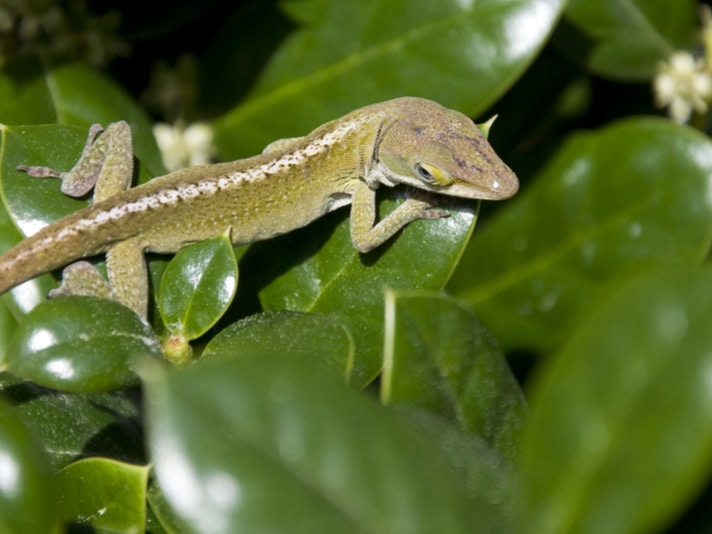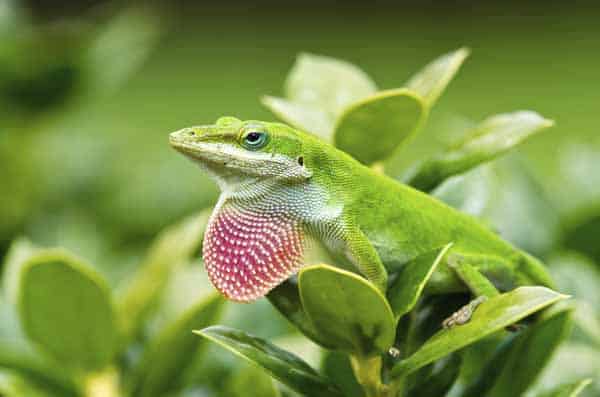Care sheet for the green anole (Anolis carolinensis)
Updated February 8, 2023
Green Anole (Anolis carolinensis)
The most commonly kept and widespread of all species of Anolis, the green anole, indigenous to the southern United States, has been popular in the pet trade since the 1950s. With a dorsal coat of lime to emerald green (very rare and gorgeous specimens are tinted blue) and possessing a vibrant, pinkish dewlap (accentuated in the males, reduced in the females), the green anole is an agile climber and acute visual hunter of spiders, grasshoppers and other insect prey. Green anoles are personable little lizards that seem to enjoy being hand-fed, and they can make great “starter” reptiles for young and beginning hobbyists. That said, they do have some specialized care requirements.
Green Anole Availability
The green anole has long been one of the most widely available species of lizard in the pet trade. Often sold as “feeders” (prey items for larger, reptile-eating species of snakes and lizards), green anoles are available at local pet shops, chain pet store retailers and from online sellers at very affordable prices; seldom does a green anole command more than a $10 price-tag.
Green Anole Size
Male green anoles may grow to 8 inches, while females seldom exceed 5 to 6 inches. Young hatch at three-quarters to 1 inch in length. With a SVL (snout-to-vent length) of a large adult male being roughly 4 inches, fully half a green anole’s length is its tail. The head of the green anole is spear-shaped or triangular in form; the large eye sockets accommodate this diurnal hunter’s keen eyes.

scnhnc052008/Shutterstock
A lithe species, the green anole is an agile and muscularly built animal. Older males are more heavy-bodied than their female counterparts. These slender lizards are lightweight for their length, which allows them to move through their canopy and vegetation with greater ease.
Hatchlings will reach sexual maturity in 18 months, and adults will continue to grow throughout the duration of their lives. Sexual dimorphism also exists in that males sport larger dewlaps and females have a whitish to cream-colored stripe down the midline of the dorsum.
Green Anole Life Span
While captive longevity may reach or slightly exceed six years, wild specimens seldom thrive for more than three years.
Green Anole Housing
Vertically oriented terrariums are preferable, as taller enclosures better accommodate the arboreal green anole’s needs. Air circulation is important, so a well-ventilated terrarium is recommended. Vertically oriented vegetative cover is an absolute necessity; acrylic vines, plastic plants that adhere to the tank walls by way of suction cups and other such cover are highly recommended. Green anoles will sooner take refuge in suspended tangles of vegetation rather than in ground-level hides or caves.
Green Anole Lighting and Temperature
Green anoles are sun-worshipping baskers, and eight hours of full-spectrum UV lighting per day is recommended. Ambient temperatures should range from the low-80s Fahrenheit during the day with nightly dips into the upper 60s to low 70s. Basking hot spots should reach the mid 90s.
Green anoles should be able to enter and exit warmer and cooler areas of the terrarium in order to thermo-regulate, because although they are baskers, green anoles definitely require shady retreats, as well. Owing to this species’ arboreal lifestyle, undertank heaters or hot-rock-style heaters are largely ineffectual as heat sources. Heat lamps (both daytime and nighttime, or moon-glow style, bulbs) work best as heating sources for a green anole enclosure.
Green anoles seem to thrive better when their terrarium is slightly elevated, such that they may look out into your home at eye-level. Achieve this by placing your anole’s enclosure on a shelf or on top of a piece of furniture. In nature, green anoles dwell in trees and other lofty locations, and anything you can do in arranging and orienting your anole’s enclosure to better simulate this elevated lifestyle is highly recommended. Being down lower can make them nervous, especially if there’s a fair amount of activity in the vicinity of their cage.
Green Anole Substrate
Untreated soil or bark substrates, mixed with decaying leaf-litter work well for green anoles. Substrates to avoid are oily or resinous or scented substrates, such as pine shavings, wood shavings, or scented paper towels. Excessively dry substrate, such as any type of sand, is also not recommended, because the green anole is a temperate species that does not naturally occur in excessively arid areas.
Green Anole Food
Green anoles will eat small invertebrates such as crickets, mealworms, farm-raised maggots, roaches (genus Blaptica), and all other insect fare. Avoid superworms or kingworms, as these possess sharp, powerful mandibles that can injure your anole. Wild-caught insects, such as grasshoppers and leafhoppers, make great supplements to your green anole’s diet, but make certain that any and all wild insects offered to your pets are free of pesticides, herbicides and any other dangerous agricultural chemical.
Green Anole Water
Wild green anoles typically lap water from leaves after a rain shower, or before the sun dries an early-morning dew. Some pets may drink standing water from a shallow dish, but all green anoles will drink water misted onto the leaves and walls of their terrarium. If you do opt to provide a water dish, be sure it’s shallow; green anoles cannot escape from deep or steep-walled water dishes and will quickly drown in deep water. Placing a stick or vine in the water dish will ensure your green anoles an escape route should one be necessary.
Green Anole Handling and Temperament
Green anoles tolerate gentle handling, and they will usually prefer to perch upon a keeper’s hand or shoulder, rather than be tightly gripped. They are fragile lizards, and their tails will break easily, so while they do tolerate gentle interaction with their keepers, it’s best to keep handling to a minimum. Newly acquired green anoles should not be handled soon after purchase; give your new pets a week or two to adapt to their new surroundings before handling them. Children should be supervised whenever handling green anoles, and anyone who handles them (or any other reptiles) should always wash their hands with antibacterial soap afterward.
Phil Purser has been writing about reptiles and amphibians since 2001. His book, Insect-Eating Lizards (TFH Publications, 2008), features green anoles and other insectivorous lizards.


